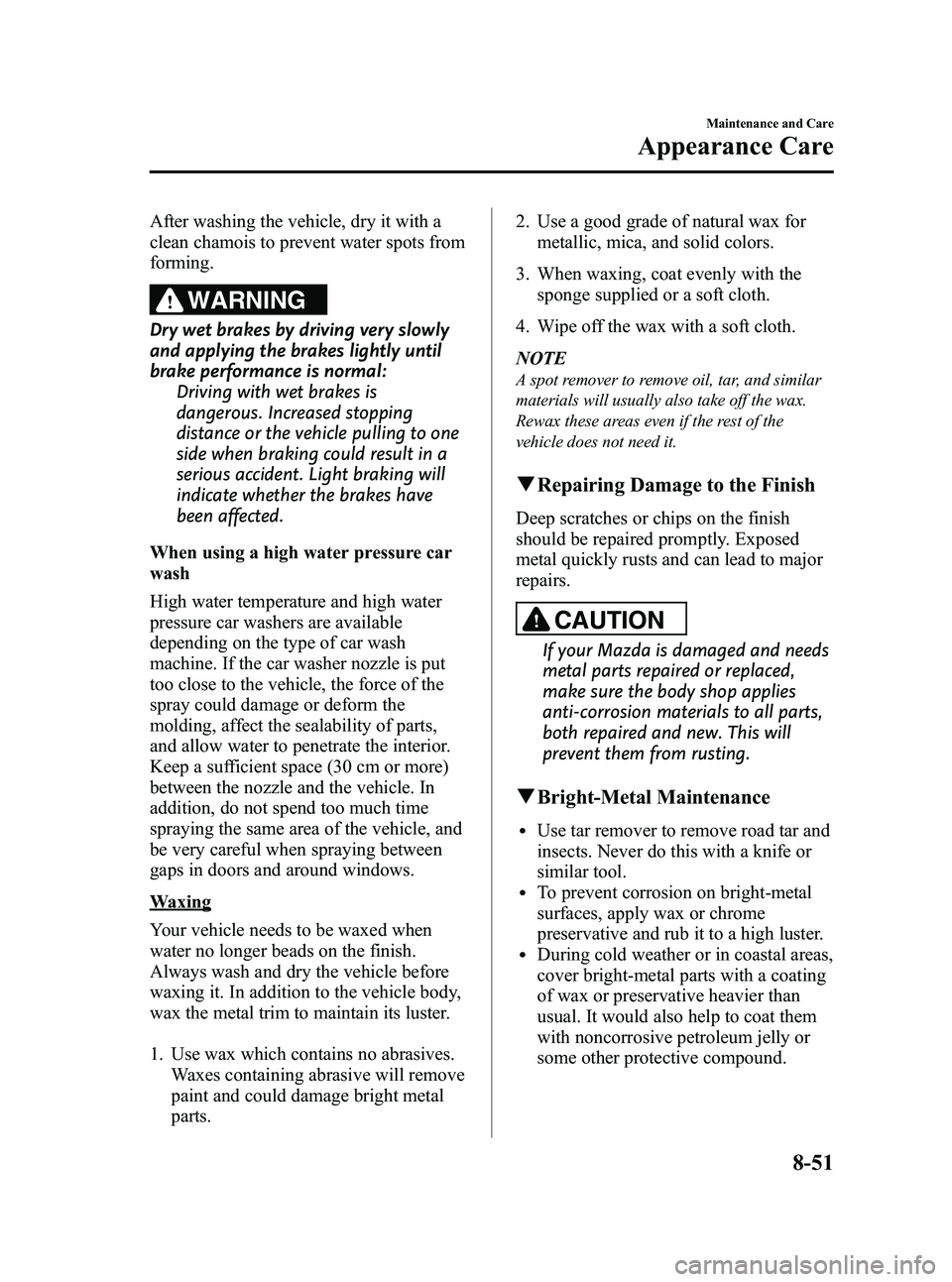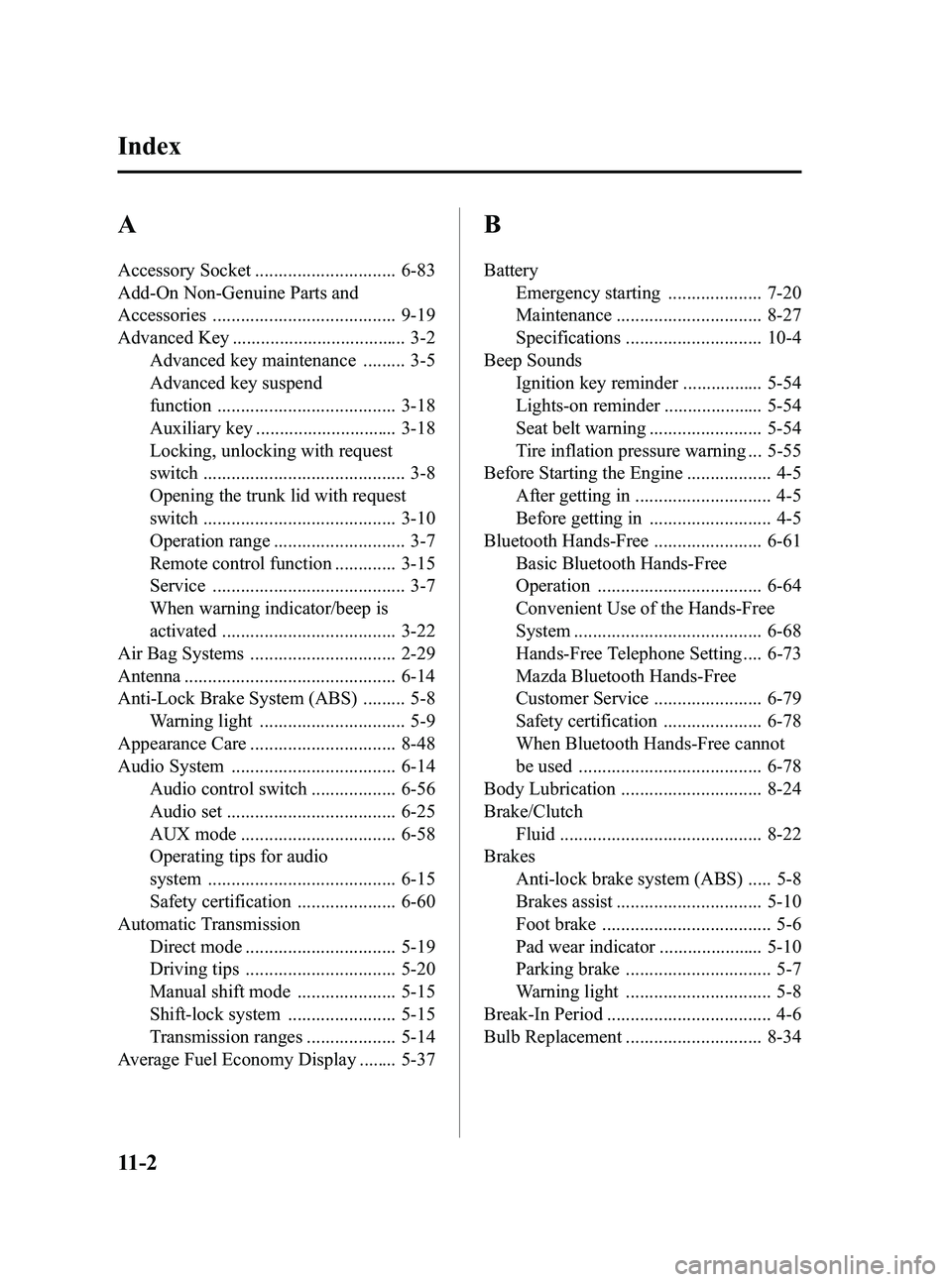brakes MAZDA MODEL MX-5 MIATA POWER RETRACTABLE HARDTOP 2010 Owner's Manual
[x] Cancel search | Manufacturer: MAZDA, Model Year: 2010, Model line: MODEL MX-5 MIATA POWER RETRACTABLE HARDTOP, Model: MAZDA MODEL MX-5 MIATA POWER RETRACTABLE HARDTOP 2010Pages: 446, PDF Size: 5.61 MB
Page 381 of 446

Black plate (381,1)
After washing the vehicle, dry it with a
clean chamois to prevent water spots from
forming.
WARNING
Dry wet brakes by driving very slowly
and applying the brakes lightly until
brake performance is normal:Driving with wet brakes is
dangerous. Increased stopping
distance or the vehicle pulling to one
side when braking could result in a
serious accident. Light braking will
indicate whether the brakes have
been affected.
When using a high water pressure car
wash
High water temperature and high water
pressure car washers are available
depending on the type of car wash
machine. If the car washer nozzle is put
too close to the vehicle, the force of the
spray could damage or deform the
molding, affect the sealability of parts,
and allow water to penetrate the interior.
Keep a sufficient space (30 cm or more)
between the nozzle and the vehicle. In
addition, do not spend too much time
spraying the same area of the vehicle, and
be very careful when spraying between
gaps in doors and around windows.
Waxing
Your vehicle needs to be waxed when
water no longer beads on the finish.
Always wash and dry the vehicle before
waxing it. In addition to the vehicle body,
wax the metal trim to maintain its luster.
1. Use wax which contains no abrasives. Waxes containing abrasive will remove
paint and could damage bright metal
parts. 2. Use a good grade of natural wax for
metallic, mica, and solid colors.
3. When waxing, coat evenly with the sponge supplied or a soft cloth.
4. Wipe off the wax with a soft cloth.
NOTE
A spot remover to remove oil, tar, and similar
materials will usually also take off the wax.
Rewax these areas even if the rest of the
vehicle does not need it.
q Repairing Damage to the Finish
Deep scratches or chips on the finish
should be repaired promptly. Exposed
metal quickly rusts and can lead to major
repairs.
CAUTION
If your Mazda is damaged and needs
metal parts repaired or replaced,
make sure the body shop applies
anti-corrosion materials to all parts,
both repaired and new. This will
prevent them from rusting.
qBright-Metal Maintenance
lUse tar remover to remove road tar and
insects. Never do this with a knife or
similar tool.
lTo prevent corrosion on bright-metal
surfaces, apply wax or chrome
preservative and rub it to a high luster.
lDuring cold weather or in coastal areas,
cover bright-metal parts with a coating
of wax or preservative heavier than
usual. It would also help to coat them
with noncorrosive petroleum jelly or
some other protective compound.
Maintenance and Care
Appearance Care
8-51
MX-5_8AV1-EA-09F_Edition5 Page381
Friday, May 7 2010 9:17 AM
Form No.8AV1-EA-09F
Page 382 of 446

Black plate (382,1)
CAUTION
Don't use steel wool, abrasive
cleaners, or strong detergents
containing highly alkaline or caustic
agents on chrome-plated or anodized
aluminum parts. This may result in
damage to the protective coating and
cause discoloration or paint
deterioration.
qUnderbody Maintenance
Road chemicals and salt used for ice and
snow removal and solvents used for dust
control may collect on the underbody. If
not removed, they will speed up rusting
and deterioration of such underbody parts
as fuel lines, frame, floor pan, and exhaust
system, even though these parts may be
coated with anti-corrosive material.
Thoroughly flush the underbody and
wheel housings with lukewarm or cold
water at the end of each winter. Try also
to do this every month.
Pay special attention to these areas
because they easily hide mud and dirt. It
will do more harm than good to wet
down the road grime without removing
it.
The lower edges of doors, rocker panels,
and frame members have drain holes that
should not be clogged. Water trapped
there will cause rusting.
WARNING
Dry wet brakes by driving very slowly
and applying the brakes lightly until
brake performance is normal: Driving with wet brakes is
dangerous. Increased stopping
distance or the vehicle pulling to one
side when braking could result in a
serious accident. Light braking will
indicate whether the brakes have
been affected.
qAluminum Wheel Maintenance
A protective coating is provided over the
aluminum wheels. Special care is needed
to protect this coating.
NOTE
lDo not use a wire brush or any abrasive
cleaner, polishing compound, or solvent on
aluminum wheels. They may damage the
coating.
lOnly use a mild soap or neutral detergent
and always use a sponge or soft cloth to
clean the wheels.
Rinse thoroughly with lukewarm or cold
water. Also, be sure to clean the wheels
after driving on dusty or salted roads. This
helps prevent corrosion.
lAvoid washing your vehicle in an automatic
car wash that uses high-speed or hard
brushes.
lIf your aluminum wheels lose luster, wax
the wheels.
(With Tire Pressure Monitoring System)
Check special requirements for Tire Pressure
Monitoring System.
Refer to Tires and Wheels on page 5-34.
8-52
Maintenance and Care
Appearance Care
MX-5_8AV1-EA-09F_Edition5 Page382
Friday, May 7 2010 9:17 AM
Form No.8AV1-EA-09F
Page 417 of 446

Black plate (417,1)
qGlossary of Terms
Tire Placard: A label indicating the OE tire sizes, recommended inflation pressure, and
the maximum weight the vehicle can carry.
Tire Identification Number (TIN): A number on the sidewall of each tire providing
information about the tire brand and manufacturing plant, tire size, and date of
manufacture.
Inflation Pressure: A measure of the amount of air in a tire.
kPa: Kilopascal, the metric unit for air pressure.
psi: Pounds per square inch, the English unit for air pressure.
B-pillar: The structural member at the side of the vehicle behind the front door.
Original Equipment (OE): Describes components originally equipped on the vehicle.
Vehicle Load Limit: The maximum value of the combination weight of occupants and
cargo.
Bead Area of the Tire: Area of the tire next to the rim.
Sidewall Area of the Tire: Area between the bead area and the tread.
Tread Area of the Tire: Area on the perimeter of the tire that contacts the road when it's
mounted on the vehicle.
Seating capacity means the total allowable number of vehicle occupants. Seating capacity
is described on the tire label.
Production options weight is the combination weight of installed regular production
options weighing over 2.3 kilograms in excess of the standard items which they replace,
and not previously considered in the curb weight or accessory weight, including heavy
duty brakes, ride levelers, roof rack, heavy duty battery, and special trim.
Rim is the metal support (wheel) for a tire or a tire and tube assembly upon which the tire
beads are seated.
Customer Information and Reporting Safety Defects
Tire Information (U.S.A.)
9-31
MX-5_8AV1-EA-09F_Edition5 Page417
Friday, May 7 2010 9:18 AM
Form No.8AV1-EA-09F
Page 421 of 446

Black plate (421,1)
Vehicle Loading
WARNING
Do not tow a trailer with this vehicle:Towing a trailer with this vehicle is dangerous because it has not been designed to
tow a trailer and doing so will affect the drive system which could result in vehicle
damage.
This section will guide you in the proper loading of your vehicle, to keep your loaded
vehicle weight within its design rating capability. Properly loading your vehicle will
provide maximum return of vehicle design performance. Before loading your vehicle,
familiarize yourself with the following terms for determining your vehicle's weight ratings,
from the vehicle's Safety Certification Label and Tire and Load Information Label:
WARNING
Overloaded Vehicle: Overloading a vehicle is dangerous. The results of overloading can have serious
consequences in terms of passenger safety. Too much weight on a vehicle's
suspension system can cause spring or shock absorber failure, brake failure,
handling or steering problems, irregular tire wear, tire failure or other damage.
Overloading makes a vehicle harder to drive and control. It also increases the
distance required for stopping. In cases of serious overloading, brakes can fail
completely, particularly on steep grades. The load a tire will carry safely is a
combination of the size of the tire, its load range, and corresponding inflation
pressure.
Never overload the vehicle and always observe the vehicle's weight ratings from the
vehicle's Safety Certification and Tire and Load Information labels.
Customer Information and Reporting Safety Defects
Tire Information (U.S.A.)
9-35
MX-5_8AV1-EA-09F_Edition5 Page421
Friday, May 7 2010 9:18 AM
Form No.8AV1-EA-09F
Page 440 of 446

Black plate (440,1)
A
Accessory Socket .............................. 6-83
Add-On Non-Genuine Parts and
Accessories ....................................... 9-19
Advanced Key ..................................... 3-2Advanced key maintenance ......... 3-5
Advanced key suspend
function ...................................... 3-18
Auxiliary key .............................. 3-18
Locking, unlocking with request
switch ........................................... 3-8
Opening the trunk lid with request
switch ......................................... 3-10
Operation range ............................ 3-7
Remote control function ............. 3-15
Service ......................................... 3-7
When warning indicator/beep is
activated ..................................... 3-22
Air Bag Systems ............................... 2-29
Antenna ............................................. 6-14
Anti-Lock Brake System (ABS) ......... 5-8 Warning light ............................... 5-9
Appearance Care ............................... 8-48
Audio System ................................... 6-14 Audio control switch .................. 6-56
Audio set .................................... 6-25
AUX mode ................................. 6-58
Operating tips for audio
system ........................................ 6-15
Safety certification ..................... 6-60
Automatic Transmission Direct mode ................................ 5-19
Driving tips ................................ 5-20
Manual shift mode ..................... 5-15
Shift-lock system ....................... 5-15
Transmission ranges ................... 5-14
Average Fuel Economy Display ........ 5-37
B
Battery Emergency starting .................... 7-20
Maintenance ............................... 8-27
Specifications ............................. 10-4
Beep Sounds Ignition key reminder ................. 5-54
Lights-on reminder ..................... 5-54
Seat belt warning ........................ 5-54
Tire inflation pressure warning ... 5-55
Before Starting the Engine .................. 4-5 After getting in ............................. 4-5
Before getting in .......................... 4-5
Bluetooth Hands-Free ....................... 6-61 Basic Bluetooth Hands-Free
Operation ................................... 6-64
Convenient Use of the Hands-Free
System ........................................ 6-68
Hands-Free Telephone Setting .... 6-73
Mazda Bluetooth Hands-Free
Customer Service ....................... 6-79
Safety certification ..................... 6-78
When Bluetooth Hands-Free cannot
be used ....................................... 6-78
Body Lubrication .............................. 8-24
Brake/Clutch Fluid ........................................... 8-22
Brakes
Anti-lock brake system (ABS) ..... 5-8
Brakes assist ............................... 5-10
Foot brake .................................... 5-6
Pad wear indicator ...................... 5-10
Parking brake ............................... 5-7
Warning light ............................... 5-8
Break-In Period ................................... 4-6
Bulb Replacement ............................. 8-34
11-2
Index
MX-5_8AV1-EA-09F_Edition5 Page440
Friday, May 7 2010 9:18 AM
Form No.8AV1-EA-09F